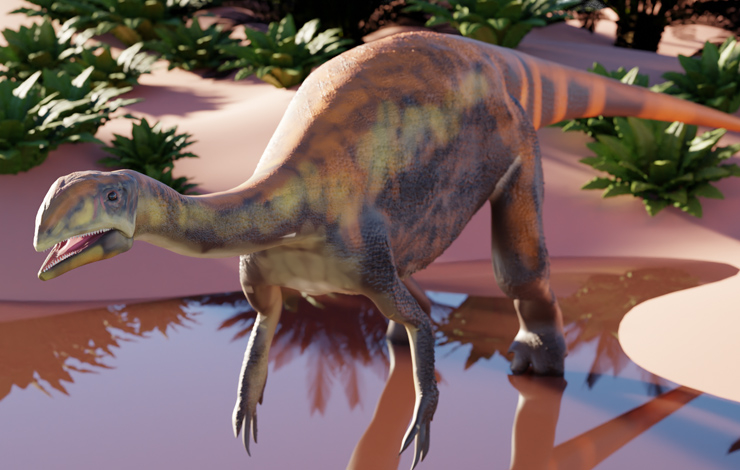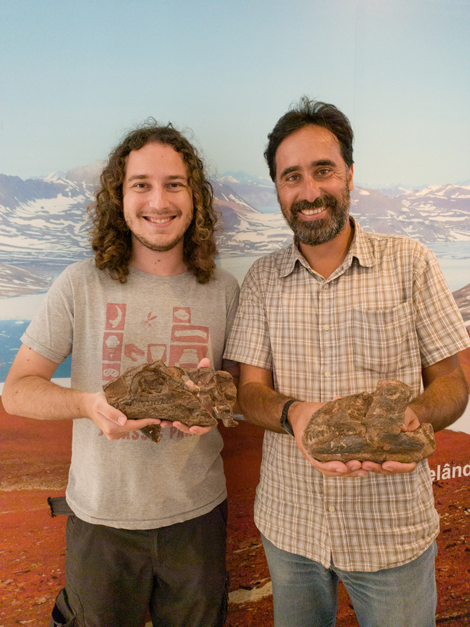04-11-2021

Some 25 years after the initial finds, an international team of paleontologists now describes “Issi saaneq” in the latest issue of the scientific journal Diversity. The first author of the work is Victor Beccari, from the NOVA School of Science and Technology in Lisbon, Portugal, and the Bayerische Staatssammlung für Paläontologie und Geologie in Munich, Germany, in collaboration with researchers from the Lourinhã Museum in Portugal, Martin Luther University Halle-Wittenberg in Germany, and Geomuseum Faxe and the University of Copenhagen, both in Denmark.
The new dinosaur name honors the local Inuit language; meaning “cold bone”. The plant-eating dinosaur lived during the late Triassic approximately 214 million years ago. During that time, the supercontinent Pangaea broke up and the Atlantic Ocean began to form. Issi saaneq is among the first sauropodomorphs (the dinosaur group from which later evolved the largest terrestrial animals of all times) to have lived on the northern hemisphere. It was a medium-sized, long-necked dinosaur, and the first sauropodomorph to have reached latitudes over 40° North.
“It is exciting to discover close relatives of the long-known Plateosaurus, of which more than one hundred individuals were found here in Germany until now” says Oliver Wings, a coauthor from the Martin Luther University in Halle-Wittenberg, Germany. “Especially with such excellent preservation and two rather complete skulls” he adds.
The first expeditions to recover vertebrate fossils in East Greenland date back to the 19th century, and numerous tetrapods have been described from there until now. These fossils span from the Devonian period to the Jurassic, and contain some iconic animals such as Ichtyostega, one of the first vertebrates to leave the oceans. During the Late Triassic, East Greenland was connected to what is now Europe. It was a transitional environment between the dry interior of Pangea, and the humid peripheral parts of the continent. At this point in time, the fauna of East Greenland was diverse, with large fishes, amphibians, phytosaurs, pterosaurs, and some of the first dinosaurs. While dinosaurs are known for almost complete skeletons and numerous trackways in Jameson Land, East Greenland, only a few of their bones are already prepared and they never have been thoroughly described.
This changes with the description of two almost complete skulls of this plant-eating dinosaur. The work was published in the open access journal Diversity this Wednesday, November 3, 2021, by an international team of researchers from Brazil, Portugal, Germany, and Denmark.
The remains of these dinosaurs were recovered by palaeontologists from Harvard University in expeditions to Greenland during the early 1990s. One of these specimens was initially assigned to Plateosaurus, an iconic Triassic sauropodomorph found in Germany, France, and Switzerland. In the present, the dinosaur fossils were studied in detail by Victor Beccari for his master’s thesis at the Master in Palaeontology, at the NOVA School of Science and Technology, under the supervision of Octávio Mateus from the same university. During his studies, enough anatomical differences in the skull bones allowed Beccari to separate the Greenland dinosaur Issi from the European Plateosaurus.
“The two skulls are unique in many aspects of their anatomy, such as their bone proportions and shapes” says Beccari. “These specimens certainly pertain to a new species, Issi saaneq”. “Back then, the Earth was going through climate changes that allowed for the first plant-eating dinosaurs to reach Europe and beyond” explains the coordinator of the work, Lars Clemmensen, from the University of Copenhagen. Clemmensen studies of the geology of East Greenland have dated the dinosaur-wilding outcrops of Jameson Land in his previous works with Dennis Kent (USA)
To study the material, both skulls were scanned using micro-CT-scan and segmented, which allowed for the visualization of internal structures and bones that were still covered by sediment, and the creation of 3D models that are available for download on the website MorphoSource. This digitization provide the basis for a thorough description of the specimen, but also made it possible for Beccari to work on his thesis during the lockdowns of Covid-19.
“This is the third new vertebrate fossil species that our team named for Greenland, which shows the scientific importance of that territory” says Octávio Mateus adding “It’s spectacular to have a thesis in our Master in Paleontology at Nova University of Lisbon with these results and quality”.
The two skulls from Issi saaneq pertain to a juvenile and a possible subadult. The differences, other than size, are minor and relate solely to proportions. The Greenland dinosaur differs from all other sauropodomorphs described so far by a set of unique features, but also show similarities with Brazilian dinosaurs, such as Macrocollum and Unaysaurus. The Brazilian dinosaurs are almost 15 million years older than Issi saaneq. Together with the European Plateosaurus, these dinosaurs and Issi saaneq form the group of plateosaurid sauropodomorphs. Plateosaurids were bipedal and gracile animals, reaching 3 to 10 meters in length.
The new dinosaur increases the diversity of dinosaurs during the Late Triassic (235-201 million years ago) and allows us to start retracing the evolutionary routes and timing for the iconic group of sauropods that roamed the Earth for almost 150 million years. The skulls of Issi saaneq are currently part of an exhibition in the Museu da Lourinhã, Portugal. More specimens from East Greenland, including a complete skeleton, were already collected and are presently on display at the Geocenter Møns Klint in Denmark awaiting further studies. Some material is currently also under preparation in the Dinosaur Park Münchehagen in Germany. After the final studies, all specimens will be curated by the Natural History Museum of Denmark.
